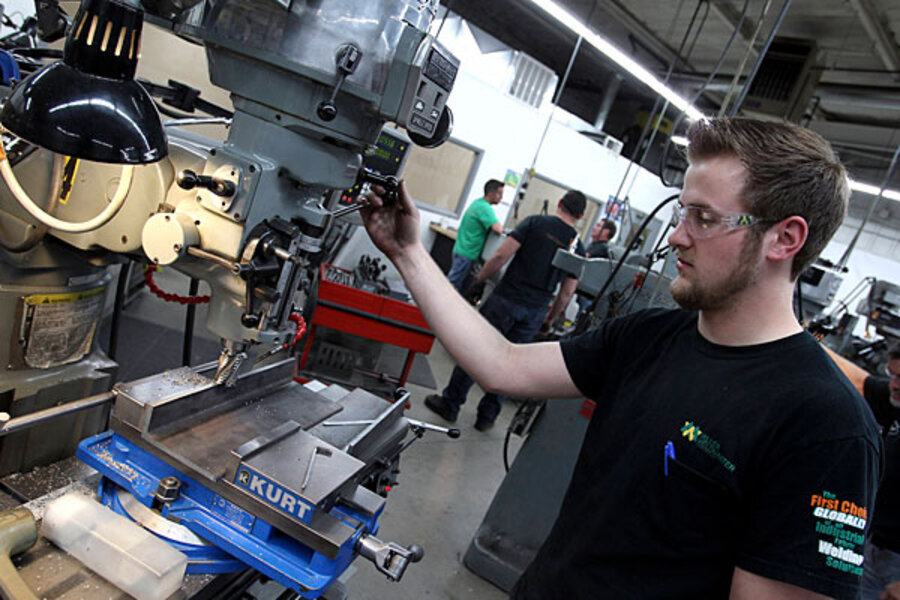Who's looking to hire? Top 10 hard-to-fill jobs hold surprising lessons.
Loading...
Did you hear about the job shortage? Probably not, amid all the talk about the chronic 8-plus percent unemployment rate and debate over which presidential candidate would be the better job creator. But there are a number of industries looking for workers, and according to a recent survey, they're not all in fields that can be filled only with college graduates and foreign computer whizzes.
They are sales reps, accountants, drivers, machinists, and people in skilled trades like plumbing. In fact, seven of the top 10 hardest jobs to fill in the US don't require a college degree, according to ManpowerGroup's, 2012 Talent Shortage Survey.
So can the US grow its way back to prosperity through vocational schools and on-the-job training? It would be a good start, say economists.
Politicians and education officials often emphasize the importance of a university education, and for good reason. A university degree increases a worker's earning power over a lifetime.
But particularly when the economic picture is dim, what an employee can get here and now becomes a more urgent concern, and the Talent Shortage Survey suggests that the economy needs people who can fix things with their hands as much as it needs high-end talent.
"The benefit of vocational education is in helping people reinvent and reinvest themselves,” says Nicholas Sly, an economist at the University of Oregon.
In its seventh annual talent-shortage survey, ManpowerGroup found that 49 percent of 1,300 US companies surveyed are having difficulty filling positions, down from 52 percent in 2011. That number is the fifth-highest among the 41 nations surveyed. The worldwide figure is 34 percent.
Of the top 10 hardest-to-fill positions in the US, only three – engineers, nurses, and teachers – require university degrees. The other seven are: skilled trades, IT staff, sales representatives, accounting and finance staff, drivers, mechanics, and machinists.
The reasons employers cannot fill these positions are lack of experience, candidates asking for more money than they can afford to pay, and lack of talent and training.
“This skills mismatch has major ramifications on employment and business success in the US and around the globe,” said Jonas Prising, ManpowerGroup president for the Americas. “Wise corporate leaders are doing something about it, and we increasingly see that they’re developing workforce strategies and partnerships with local educational institutions to train their next generation of workers.”
President Obama and Congress have acknowledged the problem. Though his demand in January's State of the Union address that colleges and universities bring tuition under control got the thunderous applause, Mr. Obama also prioritized vocational training in his proposed $69.8 billion education budget.
In June, the House education committee passed the Workforce Investment Improvement Act, which will create a fund for local and state officials to address specific needs in their communities and areas – including perhaps vocational training aimed at local employer needs.
“The bill gives states and local entities the flexibility to address their unique workforce needs,” said Rep. Virginia Foxx (R) of North Carolina, chair of the Subcommittee on Higher Education and Workforce Training.
The bill has not been scheduled for a vote on the House floor.
In a companion paper to the talent survey, ManpowerGroup makes a number of suggestions to companies on how to deal with shortages, such as providing additional training, filling the positions with people who can develop the necessary skills – in other words, who can grow into the position – and focusing more recruitment efforts and energy on the hardest-to-fill positions.
"Business leaders need to act now to establish working partnerships with the colleges, vocational institutions, and high schools in the communities where they do business,” said Jeffrey Joerres, ManpowerGroup’s chairman and CEO. “We can no longer afford to have business and education working in silos if we want US communities to compete economically in the human age."
What companies want and what an employee needs, in terms of skill acquisition, are different, but complimentary, says Professor Sly.
“The onus on workers is to develop skills that are useful to employers generally,” he says. “The burden on the company is to develop skills specific to their own needs and operations.”
Companies will invest five or six years of training in an employee before the employee is fine-tuned to the needs of that business. When the economic picture is difficult, businesses are less willing to take the risk of spending that money only to see the employee they trained move up and out of the company.
Vocational training allows workers to meet companies halfway.
“One huge advantage of vocational skills or programs is that they’re relatively quick," Sly says. "Retooling yourself at a university is an investment of, at a minimum, four years. A vocational program takes two, or even one year."







